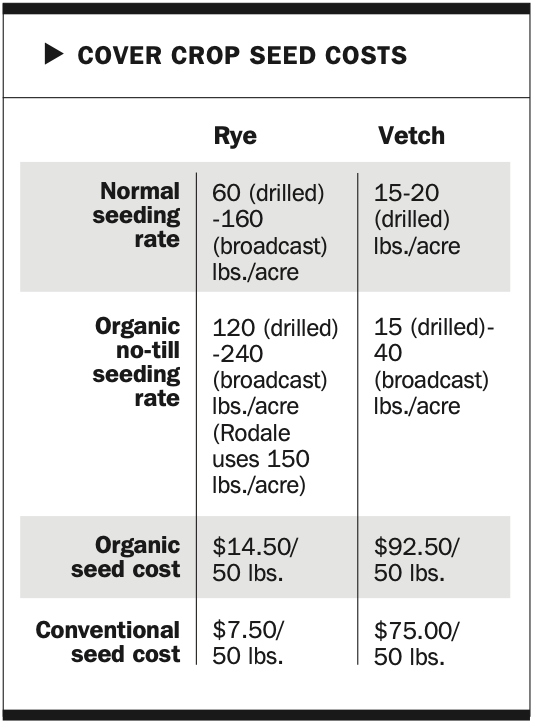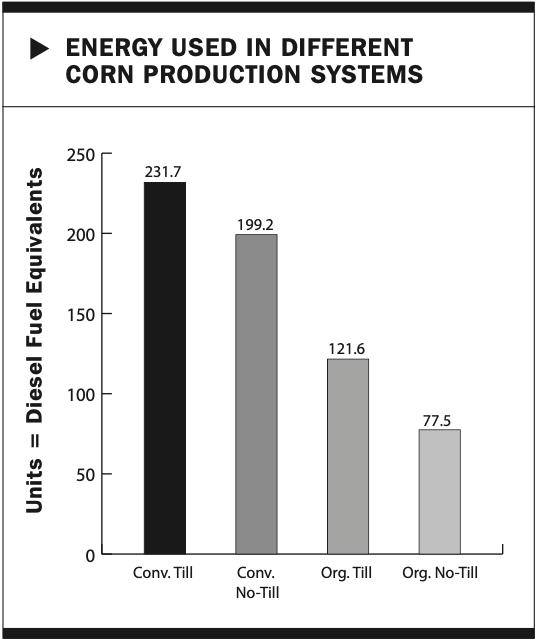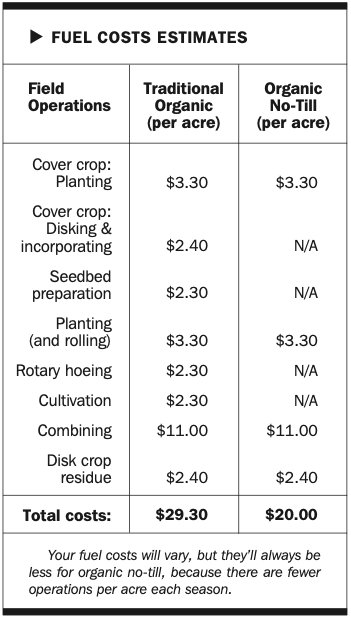Organic no-till can help a grower save on many inputs — and make more overall profit
Editor’s note: This is an excerpt from Jeff Moyer’s Roller-Crimper No-Till (2020).
An organic no-till operation involves considerable planning, as we’ve already discussed. If you are currently farming no-till, the financial investment in converting to organic no-till is fairly minimal. If you currently use conventional tillage but want to experiment with no-till, the investment is more extensive. Of course, the amount of money needed will depend on the size of your farm operation. By giving you as much information as possible about costs, we hope to help you get started with your financial planning. Although you can’t expect to become a millionaire farmer overnight, you should be able to save some money and improve your bottom line with organic no-till.
Costs
Equipment will be your biggest start-up cost — especially if you are using conventional tillage. The following is an outline of the equipment needed and the approximate costs:
- Roller/crimper: $3,000-$15,000 (depending on width)
- Front 3-point hitch: $3,000 (approx.)
- No-till planter: cost will vary depending on size, but it is worth looking to pay more for a quality planter in good condition as you’ll be expecting a lot from it.
- Planter modifications: The costs will depend on the number of planter units and the modifications required. Allow anywhere from $100 per row and up.
- Tractor: The tractor size will be governed by the planter size. The tractor must be of suitable size to pick the roller off the ground for turning. Actual operation of the roller (pushing or pulling) takes very little energy since it simply rolls over the surface of the ground.
Here’s how much Rodale spent on our start-up costs for the roller/crimper system. This might be what someone might spend for a medium-sized operation.

You will probably pay more money for seed with the organic no-till system. With organic no-till, the cover crop is extremely important, and it pays to invest money in good seed. Locally sourced organic seed may be more expensive, but it’s worth the cost. Seeding rates are higher in this system, so make sure to allow enough in your budget to cover these costs. The cash crop will have a higher seeding rate, as well to compensate for seedling loss due to the heavy mulch.


The Savings
FUEL. After a conversion to no-till, you can expect to cut your fuel costs by 50 percent or more. The number of field operations will decrease considerably. The table shows the energy used in different kinds of corn production systems. It represents all costs converted to diesel fuel equivalents and includes fuel costs.

HERBICIDE. Since herbicides are not needed in this system, you can count that as a savings. Conventional farmers may still want to budget some money for an herbicide application to take care of the few weeds that may break through the mulch.
INSECTICIDE. You should save money on insecticide costs, but you may have new pests to deal with. Conventional farmers will want to spray, and organic farmers may want to think through other strategies such as delayed planting, or field border plantings that encourage beneficial insects.
FERTILIZER. You save here too, because in most cases you are growing your own fertilizer (nitrogen) with the cover crops. If you are transitioning to organic, you may still need to budget some money for fertilizer since it takes a while for nutrients to start cycling. In other words, most of the nutrients from the cover crops won’t be available for crop use the first year. As microorganisms break down the cover crops and your organic matter goes up, you can cut back on fertilizer and achieve the same crop yields.
ROW SPACING. You might experiment with narrower rows as a way to boost yields. Since organic no-till is a one-pass system for planting with no cultivation needed, you can narrow those rows from 30 inches to 20 inches or 15 inches and even consider using a grain drill for crops like soybeans and plant on 7-inch or 8-inch rows.
The Crop Conversion Calculator is a free tool that you can use online at the New Farm website, www.newfarm.org. You can use it to compare costs for your current farm operation and an organic no-till system. To get you started, we have included two sample budgets for different farms.

Iowa State has also developed a web page for Organic Crop Production Enterprise Budgets. The worksheets can also be helpful in figuring out your budget. The website can be found at www.extension.iastate.edu/agdm/crops/html/a1-18.html.
Save money with low-cost tools or sharing tools:
- Rent a no-till planter
- Share a roller/crimper and a front end hitch with a neighbor
- Build a roller/crimper yourself
Shortcut the Learning Curve and Save Money
With any new system, there is always a learning curve, and that learning curve can cost you money. With accurate recordkeeping you can learn more the first year and prepare yourself to make important changes in successive years. This can save money, time and resources. Some of the costs you may want to keep track of are:
- Seed costs (cover crop, cash crop) and seeding rates
- Cost of manufacturing compost (if this is new for you)
- Custom operations (if you choose to outsource)
- Machinery costs (repairs and maintenance)
- Farmer labor costs
- New equipment and modifications costs
- Herbicide and insecticide costs
On-farm Research
Trying a new technique in a small area is one of the easiest ways to minimize your risk. In order to have a representative trial, it’s important that the plot is similar to other areas on your farm and to have the same growing conditions. You’ll need to have a control plot with the same conditions. For information on how to conduct on-farm research you can visit the Organic Farming Research Foundation (OFRF) website at www.ofrf.org or request the publication “On-Farm Research Guide.” Rodale also publishes a similar guide called “A Farmers Guide to On-Farm Research.”
Here are a few tips for on-farm research:
- Consult with someone experienced in designing experiments, such as your extension agent.
- Conditions within your experiment should be as uniform as possible.
- Design plots that are easy to maintain.
- Keep a notebook dedicated to the research project. Document as much as possible as you go along.
- At harvest, measure yields from each plot, and document which plot each sample comes from.
- Design your experiment so that it has between four and six replications. This will eliminate much of the natural variation.
- Randomize your plots to eliminate any other sources of bias.
- Use a control that receives your normal practice or variety. This will give you a comparison to measure your experiment against.
Even if you don’t do an official on-farm experiment, nothing is more important than good recordkeeping. Recording field operations and yield is important, but you’ll also need to return to the field often to check the planting for crop quality. Digital photos are an excellent way of recording visual observations that don’t translate well to written information.
Sharing Information with Others
Form a local group of farmers who are interested in pooling information. Although everyone will have different opinions about what will work on their farms, you may come up with some useful tips. Also check out the wealth of information online, including the New Farm forums.
The New Farm website (http://newfarm.rodaleinstitute.org/talk) has many informative forums to ask questions and share experiences. Under the No-Till Plus section, forums include the following:
- General — For questions and comments about no-till in general, the goals of The Rodale Institute’s No-Till Plus Project, and the setup of this forum.
- No-Till Equipment — Covers building, buying and modifying no-till planters, cover crop rollers and other implements.
- Cover Crops and Rotations — For discussion about choosing and testing cover crops and designing crop rotation sequences for no-till systems.
- All Organic — A place for organic growers to discuss the additional challenges and benefits of organic no-till.
Grant programs
A grant can provide start-up capital, while providing a low-risk way to explore organic no-till. For the best results, collaborate with a researcher. Non-profit organizations and universities can apply for many more kinds of grants than can individuals. The following are grant programs that accept applications from farmers.
- The Sustainable Agriculture Research and Education (SARE) program helps advance farming systems that are profitable, environmentally sound, and good for communities through a nationwide research and education grants program. SARE provides funding opportunities annually through four regions in a competitive process. www.sare.org
- The Organic Farming Research Foundation’s (OFRF) purpose is to foster the improvement and widespread adoption of organic farming systems. They sponsor research related to organic farming and help disseminate research results to organic farmers and growers. www.ofrf.org
The Environmental Quality Incentives Program (EQIP) provides a voluntary conservation program for farmers and ranchers who promote agricultural production and environmental quality as compatible national goals. EQIP may cost-share up to 75 percent of the costs of certain conservation practices. Some limited resource producers and beginning farmers may be eligible for cost-shares of up to 90 percent. www.nrcs.usda.gov/programs/eqip/














